Hot Water Heater Not Filling Up? 4 Things to Check
Author: Omar Alonso | Editor: Omar Alonso
Review & Research: Jen Worst & Chris Miller
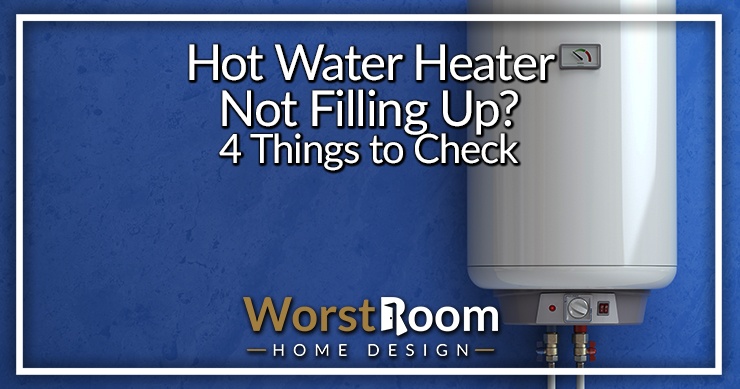
Is the hot water in your home running cold? We don't appreciate how much we value hot water until it's unavailable for the shower, bath, and sinks (not to mention the dishwasher and washing machine). The issue is with the water heater and the water heater not filling up.
If you have a tank-based water heater system in your home, the problem could be that the heater itself is past its service life, and it's starting to get faulty. Go and knock on the tank to see if it's full. If it's got water in it, there's something wrong with the control panel or thermostat.
If there's no water in the tank, that's a different story. Why is the water heater not filling up?
How Do You Know if the Water Heater Isn't Filling Properly?
Water heaters have an average service life of ten to 15 years before requiring replacement. As they reach the end of their service life, they create problems. Apart from the water tank not filling, some signs that your heater is past its sell-by date are the following:
- Leaks from the heater, either at the top or bottom of the tank
- Pooled water on the floor below the tank due to leaks
- Low pressure in the hot water faucets around the home
- The heater can't seem to produce anything but lukewarm water
- Noises like rattling, creaking, and knocking coming from the heater during operation
The later you get in the lifespan of a water heater the more likely these issues are to arise.
Why Is the Water Heater Not Filling Up? – Key Reasons & Solutions
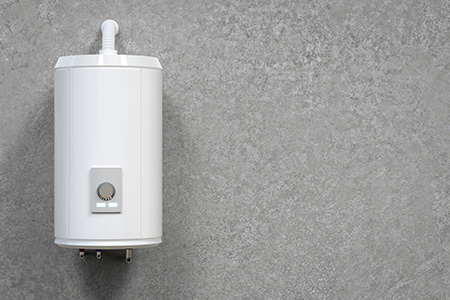
If the typical type of water heater isn't filling correctly, and it's less than ten years old, it's probably a sign of more problems to come with the unit. You'll need to start planning for a replacement. In the meantime, you can fix these minor issues as they occur and keep the heater chugging along until it finally fails and requires replacement.
Here are some reasons why the hot water tank isn't filling correctly.
Check for Water Leaks
The most common issue with tanks not filling is due to leaks. The tank might have a structural leak or a leak at the fittings where the pipes connect. If you notice puddles of water on the floor below the heater, that's a sure sign of a leak.
If there's an adjacent wall to the heater, and no puddles on the floor, check to see if it feels wet. A pipe connecting to the top of the heater might have a leak.
After checking these two areas and determining there is no leakage inside near the tank, take a trip outside before deciding a leak isn't the culprit. Some water heaters have pipes running underground. Go outside the house. Look at the base of the wall behind the water heater and check for leaks.
Most leaks require professional repairs. Fixing the water heater yourself isn't a good idea. You could burn yourself with hot water or release pressure in the tank, causing it to explode. Call a local plumber with a good reputation and ask them to inspect and repair the heater.
While you have them there, ask them if you should expect other parts of the heater to fail soon and how long they expect it to last before replacing it.
Check for Clogged Pipes
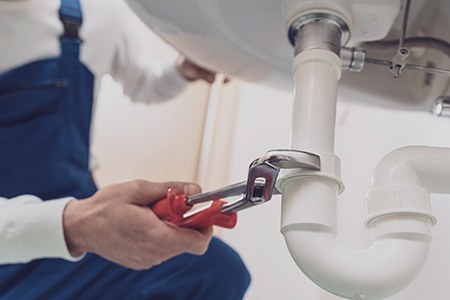
If your water heater runs on "hard" water sources, it could be clogged water delivery pipes causing the issue. Hard water is a term for water with a high pH due to high concentrations of minerals like calcium and magnesium in the water supply.
These minerals create sediment in the water tank. As the sediment layer builds over the years, the heaters inflow pipe could start to clog, reducing the water flow into the tank. You'll have to empty the tank, disconnect it from the water system and open it to look inside. If you see sediment, you'll need to remove it.
A DIY hack for removing sediment from the tank is to fill the bottom with white spirit vinegar. The vinegar will eat away the residue in 12 to 24 hours. Then open the drain valve and drain the tank. Flush it with fresh water to see if it improves drainage.
If the tank is sealed, you can't pour anything into it. In this case, you'll have to flush the unit to attempt to remove the sediment, which is the cause of the water heater not filling up. Follow these steps to flush the tank:
- If you have a gas-powered heater, turn the thermostat to the pilot position. If you have an electric model, turn the power off the heater at the circuit breaker.
- Connect a hose to the drain valve at the bottom of the tank.
- Place the other end of the hose in a bucket to collect water and sediment from the tank during the flushing process.
- Close the water supply valve to the unit. (You can turn off the recirculation pump at this stage if your model has one).
- Turn the hot water on at the faucet closest to the water heater.
- Turn the hot water faucet on at the furthest sink from the heater as well.
- Open the TPR valve at the top of the tank by lifting the lever.
- Open the drain valve and drain a gallon or two from the tank – note: the water will be hot.
- Repeat the flushing process until you see the water run clear; that means the sediment is gone.
Flushing should be performed occasionally, even if only once every few years, so the sediment doesn't have an opportunity to collect and form clogs.
Check for Airlocks
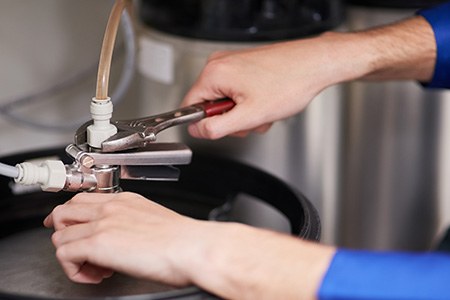
The tank might not be filling due to an airlock in the heater's pipes. Go to a hot water faucet closest to the tank and open it. If the water feels lukewarm or cold, it shows an airlock in the system. Other signs of an airlock are if the water pressure in the faucet is low or the water dribbles out.
Follow these steps to resolve the issue:
- Check that the hot and cold valves feeding the system are open.
- Go to the nearest faucet and turn the hot water on.
- Place your palm under the faucet opening to seal it.
- Open the hot water valve on the tank while keeping your hand over the faucet opening.
- Turn on the cold water faucet.
- Keep your hand over the faucet opening for around 15 seconds.
- Close the cold water faucet.
- The hot water should run at the normal temperature and pressure.
If you don't have anyone to help you open and close the faucets, try this method instead:
- Check that the hot and cold water valves connecting to the heater are open.
- Place an end of a garden hose around the hot water faucet and secure it with duct tape to prevent leaks.
- Place the other end of the hose around the cold water faucet and seal it off with duct tape.
- Open the hot water faucet and then open the cold water faucet.
- Leave them to run for five to ten seconds.
- Turn both facets off and go to another faucet somewhere in your home.
- Open the hot water faucet and see if the water runs with the correct pressure and temperature. If so, the airlock is gone.
- If it's still present, repeat the process another five times to see if it works.
- If not, call a plumber.
In some cases, the problem might be a pressure lock. Open the Temperature Pressure Relief valve (TPR valve). If the water starts entering the tank, you have a pressure lock and should call a plumber for assistance. Some issues related to a water heater not filling up shouldn't be approached by the non-professional.
Check if the Water Heater is Continuously Filling & Draining
Your tank might maintain a constant low level if continuously filling and draining. If you can hear water constantly running in the tank, it's a sign this is the problem. This issue usually occurs if the TPR valve is stuck in the open position, causing water to drain from the tank.
Usually, a stuck TPR valve occurs in old heaters past their service life. You can repair or replace the TPR valve to see if it makes a difference. We recommend you call a plumber for advice. If you need to replace your water heater entirely, it only takes two to three hours to install a water heater, so don't worry about that. Just remember to not lay the water heater on its side when doing so.
FAQs for When the Water Heater Is Not Filling Up
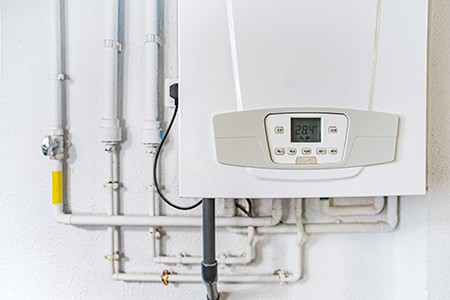
Why is my water tank not filling up? That’s the first question, and then we find the solutions. Then our minds are flooded with other similar questions. Let’s cover the most common ones now.
What Is the Most Common Problem With Water Heaters?
Water leaks are usually the most common problem with a water heater tank not refilling properly. All tanks eventually start leaking when the unit reaches the end of its service life. The average service life for water heaters varies by manufacturer. Some last as little as eight years, and others as long as 15 years.
How Long Does it Take to Fill a Water Heater?
It takes a 40-gallon electric water heater tank around 120 minutes to fill and get hot. A gas-powered heater takes approximately 60 to 70 minutes to fill and get hot.
How Does a Water Heater Know When to Stop Filling?
Water heaters hold pressures of around 150 PSI. When the pressure exceeds this threshold, it opens the pressure and temperature relief valve until the internal pressure in the tank reaches the optimal limit.
Key Takeaways for Water Heaters Not Filling Up
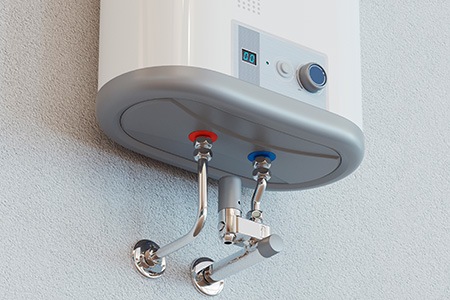
- The average hot water heater has a 10 to 15-year service life before it encounters maintenance problems, requiring repair or replacement of the unit.
- The most common reason for the water tank not filling is a leak in the pipework feeding the tank or the tank itself. Check the floor for puddles or adjacent walls to see if they feel wet.
- Airlocks or pressure locks are common problems with water tanks not filling up, or the TPR valve might be stuck in the open position.
- There might be sediment in the bottom of the tank, causing a blockage with the delivery line.
- In most cases, we recommend you call a plumber to maintain or repair the tank, don't try and fix it yourself.
Why Is My Water Heater Not Filling Up?
If you’re dealing with a water heater not filling up, it’s likely due to water leaks (even behind the wall where you wouldn’t notice), clogged pipes, an air lock in the pipes, or the TPR valve stuck in the open position. Investigate these with the guidance provided above and you’ll be back in good shape in no time.



